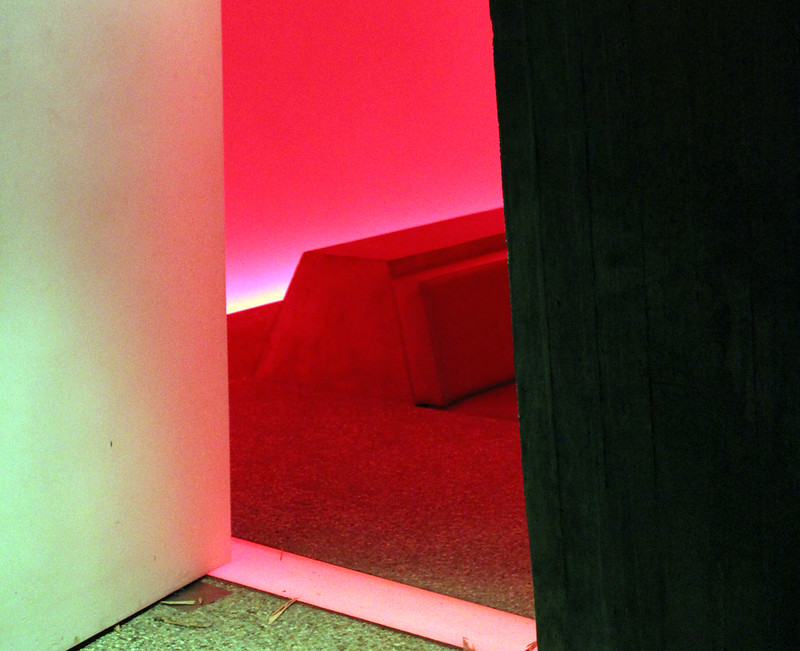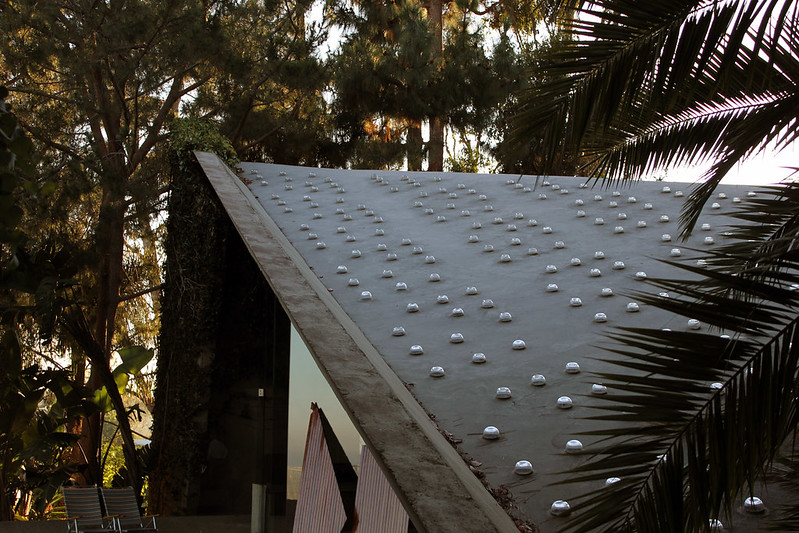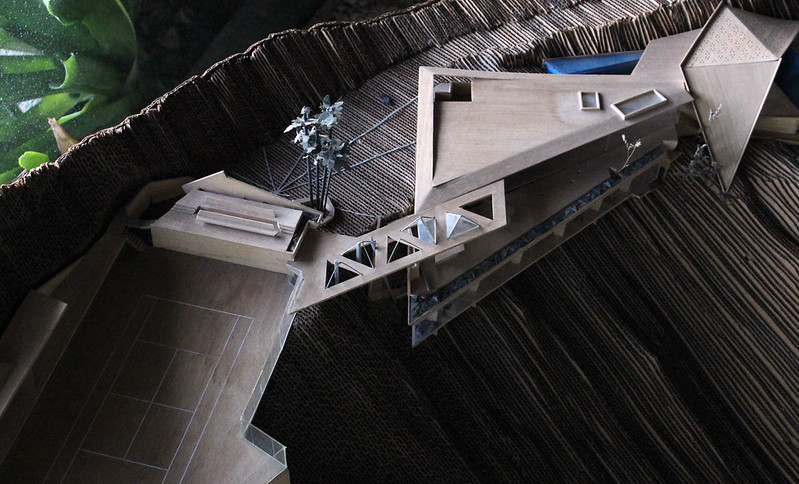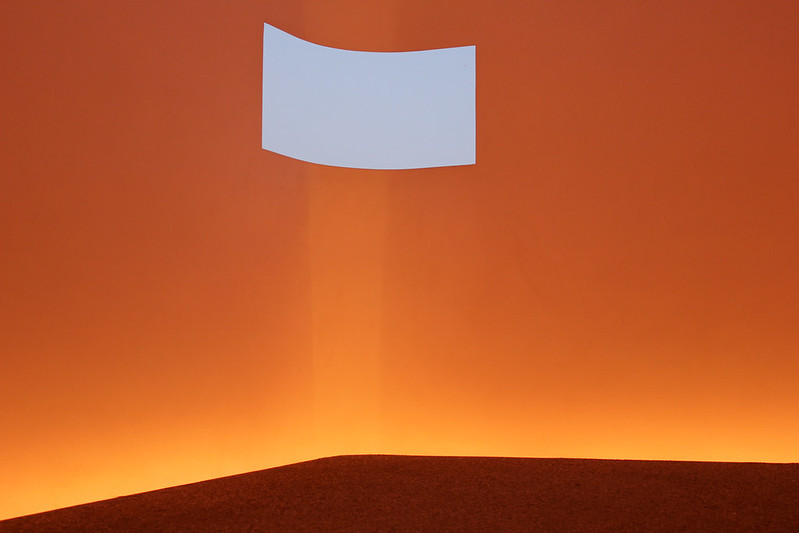One step inside , doesn't mean you understand"
- lyrics by Notwist

all photography by David John
Certain invitations you should not pass up, like touring the James Turrell skyspace at sunset with Duncan Nicholson, the architect behind this skyspace, as well as the current addition to the Sheats/Goldstein Residence. Duncan Nicholson was the last architect hired by the visionary John Lautner, and has been working on this property with Goldstein since his beginnings at Lautner's firm.
Last year when I visited this home (read more here) for what would have been Lautner's 100th birthday, I wrote, "At times, I felt like I was in an eagle's nest, high among the trees, and the smog of the city below. I dare to dream of the colors of dusk these views would allow." Well, that night, I returned to see...
Shortly after giving us a tour of the Sheats Golstein residence, Duncan led us down the floating concrete steps, gently weaving through the thick forest as the night began to approach. Around the corner, I spotted the first glimpse of the Turrell skyspace, a large concrete box of sorts. A huge thank you to Duncan and Lee Nicholson.
- David John

Are you from originally Los Angeles?
Duncan Nicholson: No, I am from Seattle originally, but I have been in LA since the 80's. I went to U.C.L.A. briefly, and I saw John Lautner's work, and I knew I didn't want to continue on, and I knew I just wanted to work with him. I got a job with Eric Lloyd Wright first, while I continually tried to get a job with John. It took me 5 years to get the job.
How did you finally get the job with Lautner?
Perseverance and contact. I met a guy in the office. It was tough, and I know because I was the low man in the office, and when you are answering the phone for the Lautner office, you know there are a lot of people calling for jobs. So I got to tell a lot of people that I was the last guy he ever hired. It was lucky, but actually I made my luck, because I really tried. Whenever I would design something that I thought was good, I would send it to him, and would write him a letter. It was really one of those things of timing, I had just got laid off at Wright's office, because the economy went sour in the early 90's, and then a couple weeks later, I received a call from the Lautner office for an interview.
Actually when I met John, he didn't want to look at any of my drawings, he just wanted to talk. It was really brief, and he just said, "I'll see what I can do." And then about 24 hours later, I got a call to come back and talk with the office manager, and then I got hired. It was awesome.
Was John Lautner the only other architect you worked with? I also worked with Eric Lloyd Wright and Art Dyson. Art Dyson worked for Frank Lloyd Wight, Bruce Goff, and William Purcell, these are all Prairie School Architects. John just worked for Wright, so my origins go back to American Organic Architecture, everybody I've worked for was part of that school.
Was the Goldstein "sykspace" started with Lautner? It was before I came into the office. I came into that office in the Fall of 89, and since it wasn't a Lautner, and I was the low man on the totem pole, I started to work on the drawings. There was only John, Helen, Julie Strickland, and then myself in the office. So it was really a small office. At the time, I had not even heard of James Turrell, so it was interesting to begin to discover him.
Tell me about the design of the Turrell skyspace? Is each one unique and built as a collaboration?
I've worked on three with him, and two are actually their own structures. Goldstein was the first skyspace I worked on, and the last was the Dallas Price skyspace in Santa Monica Canyon, and the intermediate was in the Spanish style house of Jarl Mohn, who built a movie theatre, and put an oculus and lit it with l.e.d. by the James Turrell design, but that one was not its own structure. So Goldstein and Price were their own structures, and I worked on those from beginning to end.
Typically the buildings, I'm not sure if it has changed or not, but I think this is how it still measures up; Turrell will do a plan and a section, and to an architect, that describes everything. And then, it's kind of a luck and a prayer if the owner gets it. To think 3-dimensionally is kind of an architectural concern, and a lot of owners, I don't think they do think that way, they just nod their head, and think this is going to be cool. And I know that by fact, because when I did the Dallas Price skyspace, I did the modeling with Maya, and the NY Times posted a picture of it. And the owner said, "Oh, is that what it is going to look like?" (laughing) She didn't realize what is was going to look like until there was a picture of it in the NY Times.
Duncan Nicholson: No, I am from Seattle originally, but I have been in LA since the 80's. I went to U.C.L.A. briefly, and I saw John Lautner's work, and I knew I didn't want to continue on, and I knew I just wanted to work with him. I got a job with Eric Lloyd Wright first, while I continually tried to get a job with John. It took me 5 years to get the job.
How did you finally get the job with Lautner?
Perseverance and contact. I met a guy in the office. It was tough, and I know because I was the low man in the office, and when you are answering the phone for the Lautner office, you know there are a lot of people calling for jobs. So I got to tell a lot of people that I was the last guy he ever hired. It was lucky, but actually I made my luck, because I really tried. Whenever I would design something that I thought was good, I would send it to him, and would write him a letter. It was really one of those things of timing, I had just got laid off at Wright's office, because the economy went sour in the early 90's, and then a couple weeks later, I received a call from the Lautner office for an interview.
Actually when I met John, he didn't want to look at any of my drawings, he just wanted to talk. It was really brief, and he just said, "I'll see what I can do." And then about 24 hours later, I got a call to come back and talk with the office manager, and then I got hired. It was awesome.
Was John Lautner the only other architect you worked with? I also worked with Eric Lloyd Wright and Art Dyson. Art Dyson worked for Frank Lloyd Wight, Bruce Goff, and William Purcell, these are all Prairie School Architects. John just worked for Wright, so my origins go back to American Organic Architecture, everybody I've worked for was part of that school.
Was the Goldstein "sykspace" started with Lautner? It was before I came into the office. I came into that office in the Fall of 89, and since it wasn't a Lautner, and I was the low man on the totem pole, I started to work on the drawings. There was only John, Helen, Julie Strickland, and then myself in the office. So it was really a small office. At the time, I had not even heard of James Turrell, so it was interesting to begin to discover him.
Tell me about the design of the Turrell skyspace? Is each one unique and built as a collaboration?
I've worked on three with him, and two are actually their own structures. Goldstein was the first skyspace I worked on, and the last was the Dallas Price skyspace in Santa Monica Canyon, and the intermediate was in the Spanish style house of Jarl Mohn, who built a movie theatre, and put an oculus and lit it with l.e.d. by the James Turrell design, but that one was not its own structure. So Goldstein and Price were their own structures, and I worked on those from beginning to end.
Typically the buildings, I'm not sure if it has changed or not, but I think this is how it still measures up; Turrell will do a plan and a section, and to an architect, that describes everything. And then, it's kind of a luck and a prayer if the owner gets it. To think 3-dimensionally is kind of an architectural concern, and a lot of owners, I don't think they do think that way, they just nod their head, and think this is going to be cool. And I know that by fact, because when I did the Dallas Price skyspace, I did the modeling with Maya, and the NY Times posted a picture of it. And the owner said, "Oh, is that what it is going to look like?" (laughing) She didn't realize what is was going to look like until there was a picture of it in the NY Times.

What are the typical budgets for the skyspaces?
Well, there is the artist commission, which at that time was $500,000, I believe for a Turrell cold cathode, which is neon. Then $750,000 for the l.e.d. which is probably more now. Then there is the building construction, the architectural engineering fees, and the permits, so in the end, you are really talking about a very expensive artistic installation.
The 2nd window in the Goldstein skyspace. I remember you mentioning that it was not Turrell's original idea for the second window?
I think it was both, I think Jim (Goldstein) works on common sense, but he has a good artistic eye, so he suggested it, and Turrell right away, said, that it sounded like a great thing, with no qualms or arguments.
When did the construction and plans begin for the addition to the Sheats/Golsdstein house?
John did the initial design in the Spring of '94, and there was a meeting based on that with Goldstein. I'm not sure if John was involved or not, because I know John was pretty sick at that point, but I know Helen was involved, the Chief Project Architect in the office, and then another iteration of the design in her hand, and then there was a meeting later in the summer, and the drawings show that Jim was adding his comments, which were written right on the drawing. John died in the Fall of 94, and things were put on hold, for about 10 years roughly. At about the turn of the century, we were still building the Turrell skypace , and it might have been around 2003, I remember a conversation in the Goldstein Concannon house motor court, in which Jim asked me what was going on with the new project, and I said, "not much," and he said, "well, you better get going on it." So, that was around the time it started to take off.
When do you expect it to be completed?
Probably 2020, if my foresight is 20/20 (laughing).
Tell me about the addition.
There will be a guest house, a theatre, the lower terrace, and what we are building now. So it's 2012, and we probably have another year and a half to two years, in what we are doing now, and we have a lower terrace, for another year and a half, so that is three or four left, and that takes us to 2016, and then we have two more projects scheduled, and those are going to take a couple of years each.
I've been working on this project on and off with Goldstein since I started with Lautner, pretty much. There was a little time in the beginning when John had hired me, that I was not the project architect, but Helen was. But, I worked for John for 5 years, and the last couple of years, I was the project architect. I haven't stopped doing work up there since.
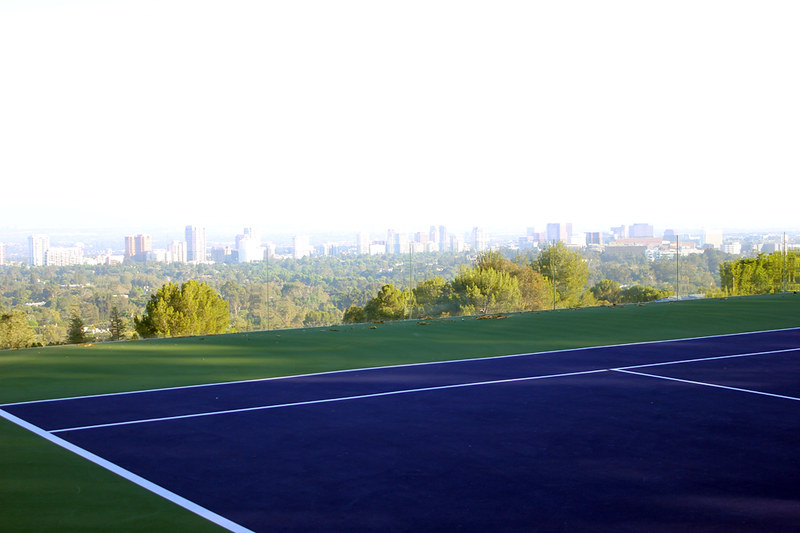
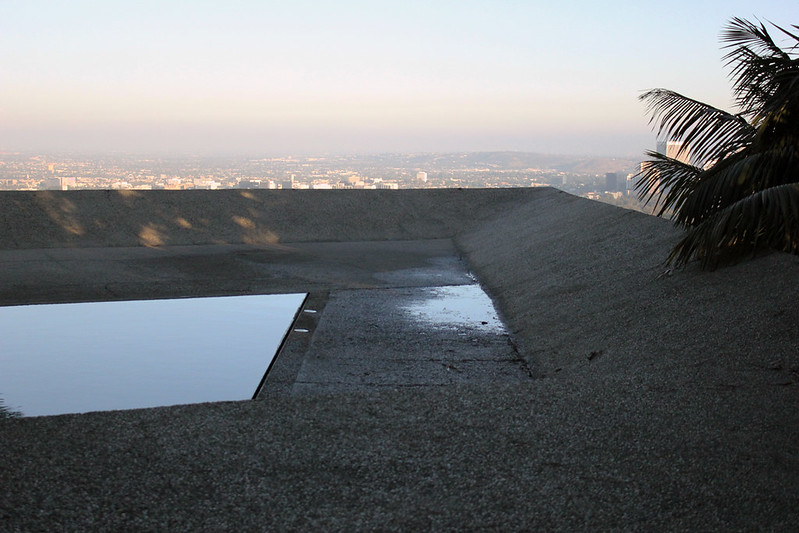
2 views: top: from the tennis courts on the new addition
below: the view from the Sheats Goldstein pool

Duncan Nicholson gave us a tour of the new addtion, expexted to be completed
in 2020. Recently poured concrete. Details of the bench and the bar.
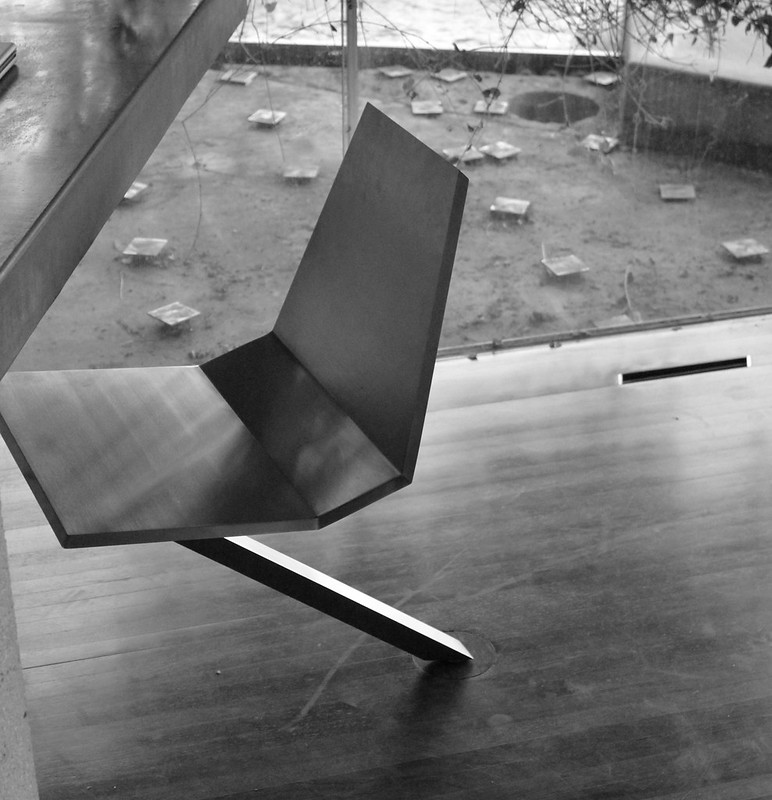
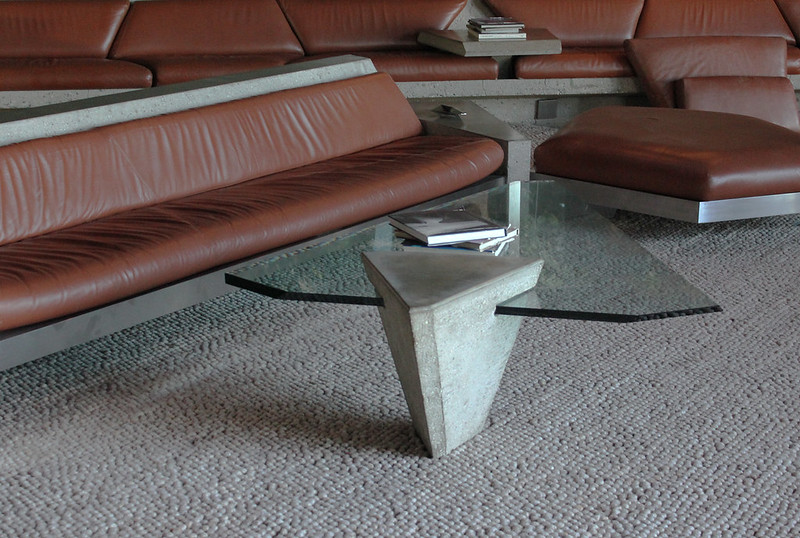
Susan Rife: What do you expect people to experience here?
James Turrell: I’m hoping to stay away from that. It is experiential. I do hope that they can feel it. Part of it is something not too often expressed in reviews and things like that: This is very emotional art. It’s taking very simple things and trying to make something that can hold your interest for an hour. You can be sitting here for a while to watch it. Some people find that there’s not enough happening, and that’s their business. I don’t have those expectations. I try to make it for the ideal viewer. Sometimes I’m able to be that myself. Sometimes when you make a show or make something it’s so much difficulty to make that I’m just happy to get through the opening and get out of there. But here, this has been done for us and done elegantly and in good spirit. I’m feeling good about that. So I can come and view it and enjoy it myself. This is how I get to see my work. And that’s a pleasure that people take enough interest to do that."
(taken from an interview here with James Turrell)
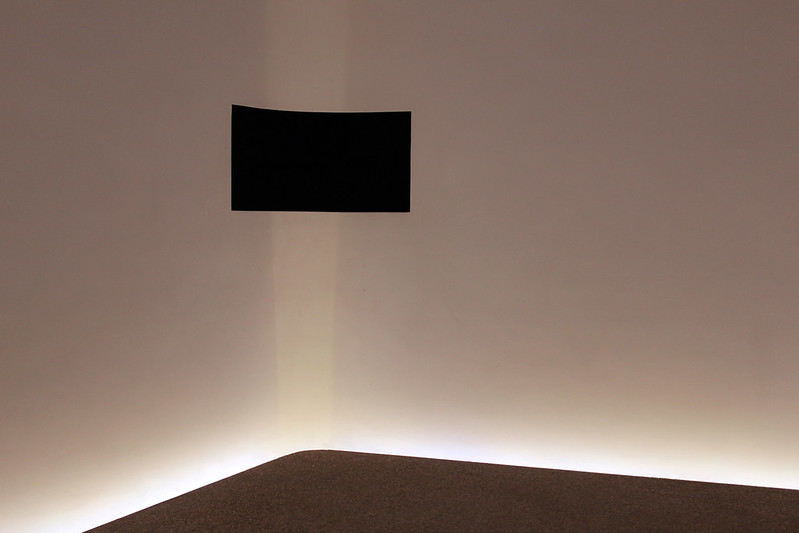
more info on Nicholson Architects here.



